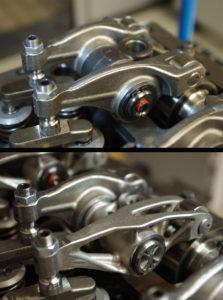Metal Additive Manufacturing Helps Renault Trucks Reduce Weight of 4-Cylinder Engine by 25% Using 3D Printed Components
 In spring of 2015, 3D artist and designer Bernhard Bauer used Blender to 3D model, from scratch, and 3D print a 1:14 scale Renault delivery truck replica for one of the company’s promotional events. Clearly Renault Trucks was impressed with the replica, and the 3D printing technology involved in creating it. Now, a team of the French trucking company’s engineers and designers are looking to metal additive manufacturing to help ramp up the performance of their engines. They are already using the futuristic technology to create complex parts through metal 3D printing, and have successfully tested some of these parts inside a Euro 6 engine.
In spring of 2015, 3D artist and designer Bernhard Bauer used Blender to 3D model, from scratch, and 3D print a 1:14 scale Renault delivery truck replica for one of the company’s promotional events. Clearly Renault Trucks was impressed with the replica, and the 3D printing technology involved in creating it. Now, a team of the French trucking company’s engineers and designers are looking to metal additive manufacturing to help ramp up the performance of their engines. They are already using the futuristic technology to create complex parts through metal 3D printing, and have successfully tested some of these parts inside a Euro 6 engine.
Renault, founded in 1894, is part of the Volvo Group (which is no stranger to 3D printing), and the company is active in over 100 countries, though the design, assembly, and production of most of its vehicles take place in France. Its commercial vehicles, weighing anywhere from 2.8 to 120 tons, are available for many transportation needs, from regional distribution to long distance deliveries and even defense. The trucks offer low fuel consumption, which allows the company to better control operating costs and deliver greater productivity.
The company’s Lyon Powertrain Engineering department has been focusing its efforts recently on utilizing metal additive manufacturing in the future processes of manufacturing the engines. The technology can offer all kinds of new development opportunities for the thermal engines. It was recently announced that 3D printing was exclusively used to help design a prototype DTI 5 four-cylinder Euro 6 step C engine.
The complete engine was already designed virtually, but the camshaft bearing caps and rocker arms were manufactured using metal 3D printing, placed inside the Euro 6 engine, and bench-tested for 600 hours with great success.
Damien Lemasson, project manager at Renault Trucks, said, “The aim of this project is to demonstrate the positive impact of metal additive manufacturing on the size and weight of an engine. This process has enabled us to reduce the weight of a 4-cylinder engine by 120 kg or 25%. The tests we have carried out prove the durability of engine components made using 3D printing. It’s not just cosmetic.”

Left: Renault Trucks DTI5 Euro 6 engine, 841 parts; Right: Same engine, designed with 3D metal printing
For companies that haul loads for a living, like Renault, using metal additive manufacturing to create complex forms can offer numerous advantages. Overall operating costs for the company’s fleet of vehicles, as well as the size of its parts, can be optimized, and there can also be a reduction in the number of assembly operations, which also means reducing the number of components in the engine. The original number of components in the Renault DTI 5 Euro 6 engine totaled almost 850. This number has been reduced by 25%, with 200 fewer parts, using metal additive manufacturing. This reduction in the engine volume will “lead to greater payloads and lower fuel consumption,” which Renault prides itself for already.
“Additive manufacturing releases us from constraints and unlocks the creativity of engineers,” explained Lemasson. “This procedure is a source of disruptive technology for the engines of tomorrow, which will be lighter and more functional, thereby offering optimal performance.”
For the time being, metal additive manufacturing will be used at Renault for just small runs and extremely specific applications. Once these initial tests are successfully completed, Renault engineers will continue working with the technology to keep increasing the functionality and overall performance of the truck components. Discuss in the Renault forum at 3DPB.com.
[Source/Images: Renault Trucks]Subscribe to Our Email Newsletter
Stay up-to-date on all the latest news from the 3D printing industry and receive information and offers from third party vendors.
You May Also Like
US Army Corps of Engineers Taps Lincoln Electric & Eaton for Largest 3D Printed US Civil Works Part
The Soo Locks sit on the US-Canadian border, enabling maritime travel between Lake Superior and Lake Huron, from which ships can reach the rest of the Great Lakes. Crafts carrying...
Construction 3D Printing CEO Reflects on Being Female in Construction
Natalie Wadley, CEO of ChangeMaker3D, could hear the words of her daughter sitting next to her resounding in her head. “Mum, MUM, you’ve won!” Wadley had just won the prestigious...
Blue Laser-powered M600 3D Printer Launched by Meltio
Founded in 2019 as a joint venture between Additec and Sicnova, metal 3D printer OEM Meltio develops and manufactures high-performance and easy-to-use metal 3D printing solutions that use its patented wire-laser metal...
3D Printed Storage Tanks Cut Material Costs by 25%
In a previous article, “Concrete Dreams: Let’s Print Money, Not Houses,” we discussed how the spotlight on 3D printing homes might be misplaced. Bollards, pedestrian bridges, and concrete tanks could...































